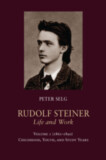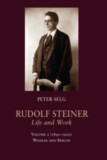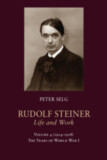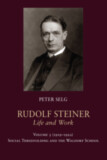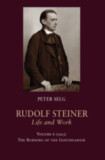Rudolf Steiner, Life and Work
1924-1925: The Anthroposophical Society and the School for Spiritual Science
- Publisher
SteinerBooks - Published
8th January 2019 - ISBN 9781621482321
- Language English
- Pages 326 pp.
- Size 6" x 9"
- Images 37
- Publisher
SteinerBooks - Published
8th January 2019 - ISBN 9781621482338
- Language English
- Pages 326 pp.
- Size 6" x 9"
“All this must be accepted as destiny [karma]. It would be sentimental to enlarge on how much it pains me to be separated physically from the Goetheanum and its activities. I hope only that all this will not inhibit but temper and enhance our dear friends’ forces.”
—Rudolf Steiner, Dec. 24, 1924
In the final volume of his comprehensive biography of Rudolf Steiner, Peter Selg describes Steiner’s last months on Earth. Although his health was beginning to decline, 1924 might have been his most productive and fruitful year. It saw a new beginning for the Anthroposophical Society and the beginning of the Esoteric School and the School for Spiritual Science.
The year began with the “Christmas Conference,” during which the Anthroposophical Society was reborn). That year also witnessed Rudolf Steiner’s “Karmic Relationships” lectures, as well as the serialized “Leading Thoughts,” summarizing Anthroposophy in a series of aphoristic guidelines for meditation, supplemented by essays on the Michaelic nature of Anthroposophy. Also serialized in the Goetheanum newsletter were autobiographical chapters in Rudolf Steiner’s life up to 1907. He also defined his important spiritual relationships with Ita Wegman, Marie Steiner, and Lili Kolisko, as well as their significant connection to the Society and his spiritual legacy.
New initiatives were also planted in the world during that time, including anthroposophically extended medicine and biodynamic agriculture. From his sickbed in the Goetheanum carpentry shop, Steiner also formed plans and a model for the new Goetheanum in Dornach, Switzerland.
Also included in this volume is a lecture by Rudolf Steiner on June 4, 1924, “The Festival of Pentecost.”
Rudolf Steiner, Life and Work, Seven Volumes
Vol. 1. (1861–1890): Childhood, Youth, and Study Years
(ISBN: 9781621480822 Pbk – ISBN: 9781621480839 Hbk)
Vol. 2. (1890–1900): Weimar and Berlin
(ISBN: 9781621480853 Pbk – ISBN: 9781621480860 Hbk)
Vol. 3. (1900–1914): Spiritual Science and Spiritual Community
(ISBN: 9781621480884 Pbk – ISBN: 9781621480891 Hbk)
Vol. 4. (1914–1918): The Years of World War I
(ISBN: 9781621481577 Pbk – ISBN: 9781621481584 Hbk)
Vol. 5. (1919–1922): Social Threefolding and the Waldorf School
(ISBN: 9781621481935 Pbk – ISBN: 9781621481942 Hbk)
Vol. 6. (1923): The Burning of the Goetheanum
(ISBN: 9781621482192 Pbk – ISBN: 9781621482208 Hbk)
Vol. 7. (1924–1925): The Anthroposophical Society and the School for Spiritual Science
(ISBN: 9781621482321 Pbk – ISBN: 9781621482338 Hbk)
C O N T E N T S:
11. The General Anthroposophical Society and the School for Spiritual Science
12. The Final Months: Dornach, October 1924 – March 1925
The Festival of Pentecost: Lecture by Rudolf Steiner, Dornach, June 4, 1924
Cited Works by Rudolf Steiner
Notes
Peter Selg
Peter Selg studied medicine in Witten-Herdecke, Zurich, and Berlin and, until 2000, worked as the head physician of the juvenile psychiatry department of Herdecke Hospital in Germany. Dr. Selg is director of the Ita Wegman Institute for Basic Research into Anthroposophy (Arlesheim, Switzerland), professor of medicine at the Alanus University of Arts and Social Sciences (Germany), and co-leader of the General Anthroposophical Section at the Goetheanum. He is the author of numerous books on Rudolf Steiner, anthroposophy, medical ethics, and the development of culture and consciousness.
Rudolf Steiner
Rudolf Steiner (b. Rudolf Joseph Lorenz Steiner, 1861–1925) was born in the small village of Kraljevec, Austro-Hungarian Empire (now in Croatia), where he grew up. As a young man, he lived in Weimar and Berlin, where he became a well-published scientific, literary, and philosophical scholar, known especially for his work with Goethe’s scientific writings. At the beginning of the twentieth century, he began to develop his early philosophical principles into an approach to systematic research into psychological and spiritual phenomena. Formally beginning his spiritual teaching career under the auspices of the Theosophical Society, Steiner came to use the term Anthroposophy (and spiritual science) for his philosophy, spiritual research, and findings. The influence of Steiner’s multifaceted genius has led to innovative and holistic approaches in medicine, various therapies, philosophy, religious renewal, Waldorf education, education for special needs, threefold economics, biodynamic agriculture, Goethean science, architecture, and the arts of drama, speech, and eurythmy. In 1924, Rudolf Steiner founded the General Anthroposophical Society, which today has branches throughout the world. He died in Dornach, Switzerland.



